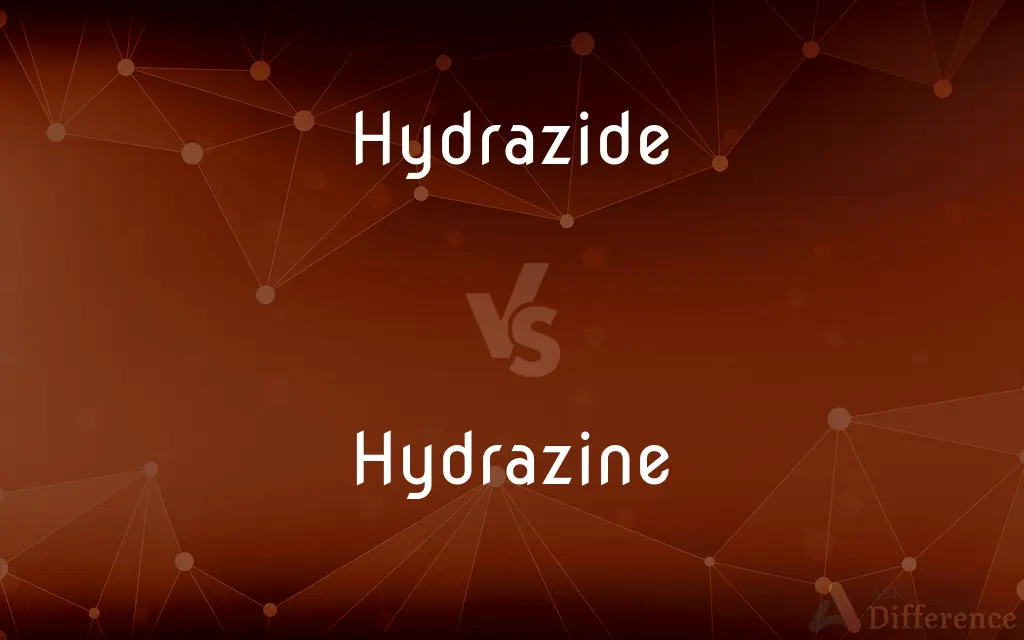Hydrazide vs. Hydrazine — What's the Difference?
By Tayyaba Rehman & Maham Liaqat — Updated on April 16, 2024
Hydrazide compounds are derivatives of hydrazine featuring an acyl group, used mainly in organic synthesis and pharmaceuticals, while hydrazine itself is a highly reactive and toxic inorganic compound used as a fuel and reducing agent.

Difference Between Hydrazide and Hydrazine
Table of Contents
ADVERTISEMENT
Key Differences
Hydrazine is a simple inorganic compound with the formula N2H4, known for its highly reactive and unstable nature. In contrast, hydrazides are more stable derivatives formed by substituting one of the hydrazine hydrogens with an acyl group, thus offering varied applications mainly in organic chemistry and drug design.
In terms of uses, hydrazine is utilized as a rocket fuel, corrosion inhibitor, and in the synthesis of blowing agents due to its reactivity. Hydrazides, however, are commonly used in the synthesis of pharmaceuticals, agrochemicals, and as intermediates in various organic reactions, reflecting their utility in more specialized chemical processes.
The synthesis of hydrazine involves oxidizing ammonia, often leading to challenges due to its toxicity and explosiveness. Meanwhile, synthesizing hydrazides typically involves reacting hydrazine with an acid chloride or anhydride, a process that is comparatively safer and can be tailored to produce specific derivatives.
Handling and safety protocols for hydrazine are stringent, requiring specialized equipment to manage its toxic and corrosive nature. On the other hand, while hydrazides also require careful handling, they are generally less hazardous than hydrazine, making their use more manageable in laboratory and industrial settings.
Regarding environmental impact, hydrazine is considered more hazardous, with significant risks associated with its release into the environment. Hydrazides, while still requiring cautious disposal, typically pose fewer risks, facilitating their adoption in a wider range of applications.
ADVERTISEMENT
Comparison Chart
Chemical Structure
N2H4
R-CO-NH-NH2
Uses
Rocket fuel, corrosion inhibitor
Pharmaceutical synthesis, organic synthesis
Synthesis
Oxidation of ammonia
Reaction of hydrazine with acid chloride
Handling and Safety
Highly toxic, explosive
Less hazardous, but still requires caution
Environmental Impact
High toxicity and risk
Comparatively lower risk
Compare with Definitions
Hydrazide
Known for its application as a reducing agent in chemical synthesis.
Hydrazine reduces metal salts to pure metals.
Hydrazine
Organic compounds containing a -CO-NH-NH2 group.
Benzohydrazide is used in the synthesis of various dyes.
Hydrazide
Utilized in water treatment and boiler systems.
Hydrazine scavenges oxygen to prevent corrosion in steam boilers.
Hydrazine
Formed by the condensation of hydrazine with carboxylic acids or their derivatives.
Acetic hydrazide is produced from acetic acid.
Hydrazide
Acts as a precursor to a variety of pesticides and pharmaceuticals.
Hydrazine derivatives are important in medicinal chemistry.
Hydrazine
Plays a role in the synthesis of various hydrazone-based drugs.
Hydrazides are key intermediates in developing antitubercular agents.
Hydrazide
Requires careful handling due to its toxicity and reactivity.
Special precautions are taken when using hydrazine in industrial settings.
Hydrazine
Less hazardous than hydrazine, making them safer for use in research.
Laboratory procedures with hydrazides are generally less strict.
Hydrazide
A colorless, flammable liquid with an ammonia-like odor.
Hydrazine is used as a propellant in emergency power units.
Hydrazine
Can be tailored for specific chemical properties in drug design.
Modifications to the hydrazide group alter drug activity.
Hydrazide
Hydrazides in organic chemistry are a class of organic compounds with the formula RNHNH2 where R is acyl (R'CO-), sulfonyl (R'SO2-), or phosphoryl (R'2P(O)-). Unlike hydrazine and alkylhydrazines, hydrazides are nonbasic owing to the inductive influence of the acyl, sulfonyl, or phosphoryl substituent.
Hydrazine
Hydrazine is an inorganic compound with the chemical formula N2H4. It is a simple pnictogen hydride, and is a colourless flammable liquid with an ammonia-like odour.
Hydrazide
A hydrazine derivative of an oxyacid, usually a carboxylic acid.
Hydrazine
A colorless, fuming, corrosive hygroscopic liquid, H2NNH2, used in jet and rocket fuels.
Hydrazide
(chemistry) any compound derived from an oxoacid by replacing the hydroxide group with -NHNH2 or derived forms -NRNR2
Hydrazine
A corrosive, fuming liquid, NH2-NH2, used as a rocket fuel.
Hydrazine
Any member of the class of organic compounds formally derived from NH2-NH2.
Hydrazine
Any one of a series of nitrogenous bases, resembling the amines and produced by the reduction of certain nitroso and diazo compounds; as, methyl hydrazine, phenyl hydrazine, etc. They are derivatives of hydrazine proper, H2N.NH2, which is a doubled amido group, recently (1887) isolated as a stable, colorless gas, with a peculiar, irritating odor. As a base it forms distinct salts. Called also diamide, amidogen, (or more properly diamidogen), etc.
Hydrazine
A colorless fuming corrosive liquid; a powerful reducing agent; used chiefly in rocket fuels
Common Curiosities
How do hydrazides differ from hydrazine in structure?
Hydrazides have an acyl group replacing one hydrogen of hydrazine.
Why is hydrazine considered more dangerous than hydrazides?
Due to its high toxicity, reactivity, and potential for explosiveness.
What is the basic structure of hydrazine?
N2H4, featuring a pair of nitrogen atoms bonded together with four hydrogen atoms.
What makes hydrazides suitable for pharmaceutical research?
Their chemical stability and ability to undergo selective reactions.
What are common applications of hydrazides?
In pharmaceutical synthesis, especially in the creation of antitubercular drugs.
What are the primary uses of hydrazine?
As rocket fuel, in corrosion inhibition, and in the production of foaming agents.
Can hydrazides be used in drug development?
Yes, they are valuable intermediates in the synthesis of various drugs.
How is hydrazine synthesized?
Typically by the oxidation of ammonia using bleach or other oxidizing agents.
What are the safety precautions for handling hydrazine?
Use of protective gear, proper ventilation, and stringent storage conditions.
Are there environmental concerns associated with hydrazine?
Yes, it is highly toxic to aquatic life and can cause long-term environmental damage.
Share Your Discovery

Previous Comparison
Firedrake vs. Dragon
Next Comparison
Sash vs. ShashAuthor Spotlight
Written by
Tayyaba RehmanTayyaba Rehman is a distinguished writer, currently serving as a primary contributor to askdifference.com. As a researcher in semantics and etymology, Tayyaba's passion for the complexity of languages and their distinctions has found a perfect home on the platform. Tayyaba delves into the intricacies of language, distinguishing between commonly confused words and phrases, thereby providing clarity for readers worldwide.
Co-written by
Maham Liaqat














































